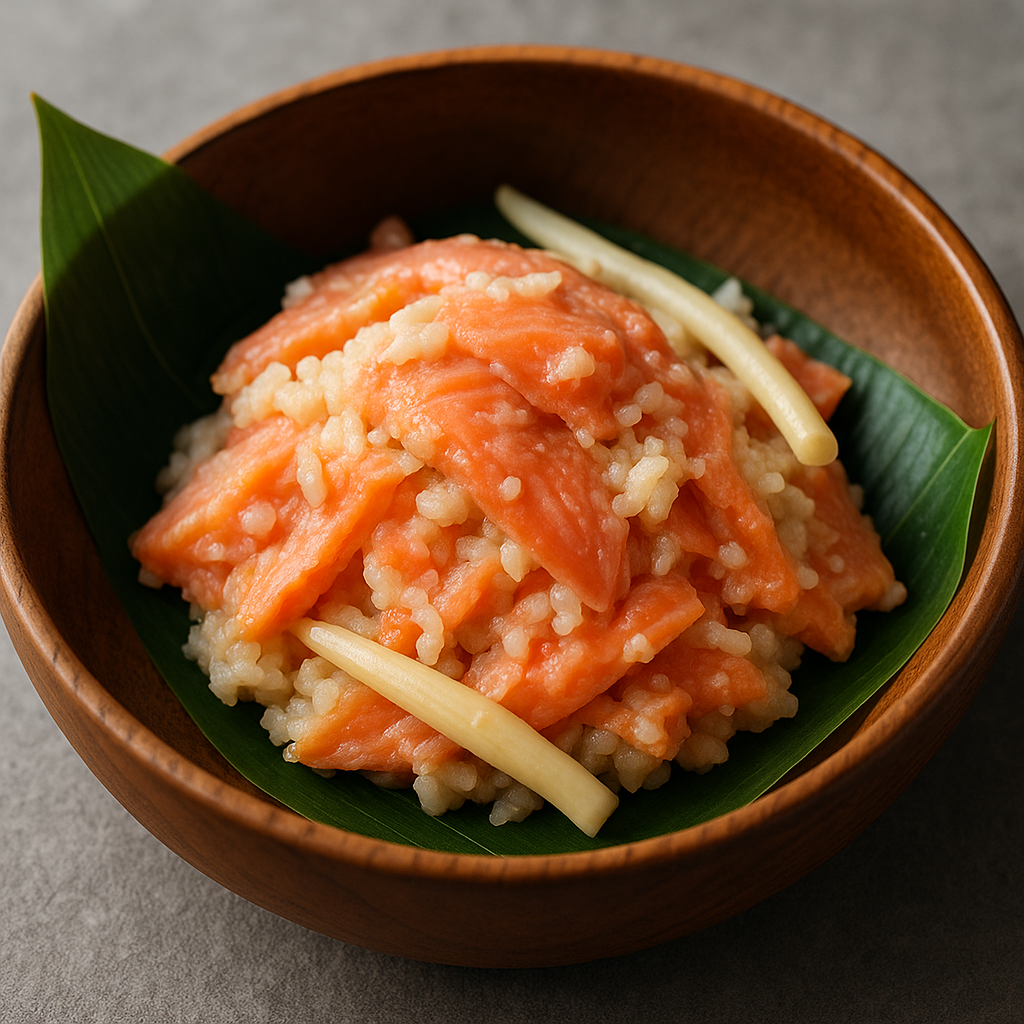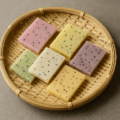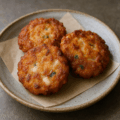鮭のいずし(青森)の特徴
北奥羽の冬を彩る“発酵寿司”
「いずし」は、塩した魚を米・米麹・酢・野菜と重ねて短期発酵させる北日本の郷土寿司。青森では秋~冬の鮭で仕立て、さっぱりとした酸味と麹由来の甘み、昆布の旨みが一体になります。
米麹×酢で安心・爽やか
米麹の酵素で身がやわらかくなり、乳酸発酵で旨みが増幅。酢と低温管理で雑菌の繁殖を抑えつつ、数日で食べ頃になる“早なれ”タイプです。
野菜と昆布が香りと食感を添える
大根・にんじん・生姜、細切り昆布、赤唐辛子が定番。青森らしくりんご薄切りを少量加えると、爽やかな香りが立ちます(好みで)。
鮭のいずし(青森)のレシピ
材料(作りやすい量/完成約1.2〜1.5kg)
- 生鮭(刺身品質・皮骨除く) … 500g
- 塩 … 鮭の5%(25g)<下漬け用>
- 炊いたご飯 … 320g(温かくない常温)
- 米麹(生または乾燥) … 150g(手でほぐす)
- 米酢 … 150ml
- 砂糖 … 40〜60g(甘さは好みで)
- 酒 … 大さじ2
- 大根 … 200g(薄い半月切り・軽く塩もみ)
- にんじん … 80g(細切り)
- 生姜 … 10g(細切り)
- 昆布 … 10g(細切り)
- 赤唐辛子 … 1本(小口切り)
- (好みで)りんご … 1/4個(薄切り)
衛生・安全の下準備(重要)
- 鮭は−20℃で24時間以上凍結→冷蔵解凍して使用(寄生虫対策)。
- 容器・落とし蓋は熱湯またはアルコールで消毒、手袋・清潔な道具を使用。
- 仕込み〜熟成は5〜8℃の冷蔵帯で管理。
作り方
- 下漬け:鮭を1cm幅のそぎ切りにし、全体に5%の塩をまぶして冷蔵で6〜12時間。出た水分を拭き、酢少量でさっと洗って水気をよく拭く。
- 床(とこ)を作る:ボウルでご飯+米麹を手でほぐし、米酢・砂糖・酒を混ぜる。味は“やや甘酸っぱめ”。
- 野菜の下処理:大根は塩少々で軽くもみ、10分置いて水気を絞る。にんじん・生姜はそのまま、昆布は細切り、唐辛子は小口切り。
- 重ねる:消毒した容器に昆布少々→床→鮭→野菜→床…と重ね、最上面は床で覆う。赤唐辛子をところどころに。
- 圧をかける:落としラップを密着させ、落とし蓋+軽い重し(内容物の0.3〜0.5倍)を乗せる。
- 熟成:冷蔵(5〜8℃)で3〜5日。1日1回上下を返すと均一に仕上がる。酸味が丸くなり、香りが立てば食べ頃。
- 提供:軽く汁気を切って盛り付け。残りは清潔な容器で冷蔵し、風味の良い2〜3日以内に食べ切る。
シェフのワンポイントアドバイス
- 酢と塩は控えすぎない(安全性と味のキレの要)。甘みは砂糖で微調整。
- 麹が多いほど早く柔らかくなるが、風味が強すぎる場合はご飯を増やしてバランスを。
- 異臭・異様な泡立ち・カビ色(黒/緑/ピンク)が出たら食べないで廃棄。
栄養価(1人分の目安/約100g)
- エネルギー:約120〜180 kcal
- たんぱく質:10〜14 g
- 脂質:5〜9 g(鮭由来のEPA・DHA)
- 炭水化物:8〜14 g(ご飯・麹・砂糖由来)
良質なたんぱく質とn-3系脂肪酸が摂れる一品。発酵でうま味が増し、少量でも満足感があります。
歴史
冬の保存と“早なれ”文化
雪国の低温を活かし、冬に仕込んで正月〜寒の時季に味わう発酵寿司として定着。米と麹、昆布を合わせる製法は北前船交易の影響も指摘されています。
家庭ごとに受け継がれる味
具や甘酸っぱさ、麹量は家ごとの“勘どころ”。数の子を添える、りんごを少量混ぜるなど、青森らしいアレンジも楽しまれています。
English Version
Features of Salmon Izushi (Aomori)
A “fermented sushi” that brightens winters in North Ōu
Izushi is a northern Japanese style of fermented sushi made by layering salted fish with rice, rice malt (koji), vinegar, and vegetables for a short fermentation. In Aomori it’s prepared with autumn–winter salmon, uniting clean acidity, koji-derived sweetness, and kombu umami.
Koji × vinegar for safety and freshness
Koji enzymes gently tenderize the flesh while lactic fermentation deepens savor. Vinegar and low temperatures suppress unwanted microbes, yielding a quick-matured style ready in a few days.
Vegetables and kombu add aroma and texture
Daikon, carrot, ginger, shredded kombu, and red chili are classics. A small addition of thin-sliced apple lends a refreshing Aomori touch (optional).
Recipe
Ingredients (easy batch; yields ~1.2–1.5 kg finished)
- Fresh salmon (sashimi-grade; skin & bones removed) … 500 g
- Salt … 5% of salmon (25 g) <for pre-salting>
- Cooked rice … 320 g (cooled to room temperature)
- Rice koji (fresh or dried) … 150 g (crumble by hand)
- Rice vinegar … 150 ml
- Sugar … 40–60 g (to taste)
- Sake … 2 tbsp
- Daikon … 200 g (thin half-moons; lightly salted and squeezed)
- Carrot … 80 g (thin matchsticks)
- Ginger … 10 g (fine matchsticks)
- Kombu … 10 g (finely shredded)
- Dried red chili … 1 (thinly sliced)
- (Optional) Apple … 1/4 (thinly sliced)
Hygiene & Safety Prep (Important)
- Freeze salmon at −20 °C for 24+ hours, then thaw in the fridge before use (parasite control).
- Sterilize containers and drop-lids by boiling water or alcohol; use gloves and clean tools.
- Keep all stages (packing → maturation) at 5–8 °C.
Instructions
- Pre-salt: Slice salmon on a bias into ~1 cm pieces. Rub evenly with 5% salt and refrigerate for 6–12 hours. Wipe off exuded liquid, rinse quickly with a splash of vinegar, and pat completely dry.
- Make the “bed”: In a bowl, crumble rice + koji, then mix in vinegar, sugar, and sake. Aim for a “slightly sweet–tart” taste.
- Prep vegetables: Lightly salt daikon 10 minutes and squeeze. Leave carrot and ginger as is; shred kombu; slice chili.
- Layer: In a sterilized container, build layers: a little kombu → koji–rice bed → salmon → vegetables → bed … Finish with a top layer of bed; dot with chili here and there.
- Weight: Press on plastic wrap to contact the surface, add a drop-lid and a light weight (about 0.3–0.5× the contents).
- Mature: Refrigerate at 5–8 °C for 3–5 days. Flip once daily for even curing. When acidity has rounded and aroma blooms, it’s ready.
- Serve: Drain lightly and plate. Store leftovers airtight in the fridge and enjoy within 2–3 days for best flavor.
Chef’s Tips
- Do not skimp on salt and vinegar—they’re key to safety and brightness. Adjust sweetness with sugar.
- More koji speeds softening; if flavor gets too intense, increase rice to rebalance.
- If you notice off-odors, unusual froth, or mold colors (black/green/pink), discard the batch.
Nutritional Value (per serving, ~100 g)
- Calories: ~120–180 kcal
- Protein: 10–14 g
- Fat: 5–9 g (EPA/DHA from salmon)
- Carbohydrates: 8–14 g (from rice, koji, sugar)
Supplying quality protein and n-3 fatty acids, its fermentation-enhanced umami gives high satisfaction in modest portions.
History
Winter preservation and the “quick-mature” tradition
Harnessing wintry low temperatures, households prepared it in winter to enjoy from New Year through the cold season. Combining rice, koji, and kombu reflects influences attributed to Kitamae-bune trade.
A taste handed down by each household
Ingredient choices, sweet–sour balance, and koji ratio are matters of family know-how. Local touches in Aomori include adding kazunoko or a little apple for fragrance.



何でも質問してください!